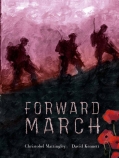‘Come on,’ urged Hansel. ‘We haven’t got all night!’
‘Oh, yes we do,’ I teased, looking at my cards. I had a lousy hand, but I wasn’t going to let Hansel beat me.
‘Hurry up!’ he yelled at me, good naturedly, flinging a pillow in my direction, scattering my cards on the floor.
I ducked, recovered the pillow and launched it back at him.
‘Oh, what’s the use?’ he grinned, catching the pillow and settling it behind him. ‘I was going to beat you anyway.’
‘Never. But if you want to think so then …’
I was staying the night at Hansel’s house. His father, the Baron von Leitner, had retired hours ago, and we were making our last night together in Vienna last as long as we could.
‘Come on,’ urged Hansel. ‘We haven’t got all night!’
‘Oh, yes we do,’ I teased, looking at my cards. I had a lousy hand, but I wasn’t going to let Hansel beat me.
‘Hurry up!’ he yelled at me, good naturedly, flinging a pillow in my direction, scattering my cards on the floor.
I ducked, recovered the pillow and launched it back at him.
‘Oh, what’s the use?’ he grinned, catching the pillow and settling it behind him. ‘I was going to beat you anyway.’
‘Never. But if you want to think so then …’
I was staying the night at Hansel’s house. His father, the Baron von Leitner, had retired hours ago, and we were making our last night together in Vienna last as long as we could.
Louis and his brother Thomas are French/Australian and their father works for the French Embassy in Europe. They have friends from all over Europe. The family are on holiday near Sarajevo when the Archduke is assassinated and before long, WWI is declared. This means that Louis and some of his friends will now be on different sides of this conflict. As the war begins and then continues through 1914, Louis and friends all make decisions about how to contribute. Louis is too young, and not fit to be a soldier, but he finds his own way to be involved. His decisions do not always keep him out of danger, and his family do not escape unscathed, but Louis stays true to himself and to his friends. ‘1914’ includes newspaper articles, photos, letters and other text types.
1914 is the first of what will be five independent novels about WWI. Each will have their own story and be written by a different author. Each will concentrate on a particular year of the war. Louis’s story includes a non-soldier perspective of the war and helps to introduce readers to one of the less well-known ways (actually more than one) that people were involved. Many readers may know how WWI began, but Masson takes them on location in Eastern Europe and allows them to feel the shockwaves that roll in so many directions. 1914 offers many opportunities for classroom discussion, including friendship, politics, loyalty and security.
Recommended for secondary readers.

1914 , Sophie Masson Scholastic Press 2014 ISBN: 9781743622476
www.clairesaxby.com
 Tim takes me back to my home in Lille.
Tim takes me back to my home in Lille.




 In towns and cities across Australia bells ring,
In towns and cities across Australia bells ring, The rough and ready fighting spirit of the Australians had become refined by an experienced battle technique supported by staff work of the highest order. The Australians were probably the most effective troops employed in the war on either side.’ Major General John O’Ryan, US 27th Division.
The rough and ready fighting spirit of the Australians had become refined by an experienced battle technique supported by staff work of the highest order. The Australians were probably the most effective troops employed in the war on either side.’ Major General John O’Ryan, US 27th Division. Shooting stars, kisses, grenades and the lumbering tanks. And the shrieking skies and the shaking comrades: ‘Up and over, lads!’
Shooting stars, kisses, grenades and the lumbering tanks. And the shrieking skies and the shaking comrades: ‘Up and over, lads!’